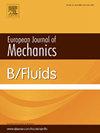Natural convection heat transfer and intensification for a discrete heat source in a vertical annulus
IF 2.5
3区 工程技术
Q2 MECHANICS
引用次数: 0
Abstract
The decay heat removal in advanced nuclear power plants encourages the use of natural convection cooling as a precaution during power outages. The ongoing designs of micro nuclear reactors institute an ambient air-cooled system via natural convection, which points to a localized heat source cooling in an open loop. The analyses presented in this paper address the problem of natural convection heat transfer of a heat source placed in an open-ended annular channel. Numerical simulations were carried out for various heat source lengths, moved along the inner cylinder of the annulus. Using the transition SST turbulence model, the influence of the annular gap size on heat transfer rates was investigated by adjusting the radius ratios between 3 and 5, while heat transfer enhancement was achieved by way of longitudinal fins. Results of heat transfer rates, local heat transfer characteristics, and mass flow rates are presented. The change in elevation of the heat source at Lc/b > 2.7 in the open system did not have a profound influence as indicated by the Rayleigh number buoyancy parameter and Nusselt numbers. However, the annular gap size was unequivocally the most influential geometrical parameter. Additionally, the average Nusselt numbers at any unfinned heated section length were adequately described by the correlation NuL = 0.959NuH(L/H)0.855, for . The number of fins and the fin height were the most important parameters for the finned system where case-specific gains of more than 50 % in average Nusselt number were obtained. The results of the present analyses provide invaluable information for the development of passively cooled systems utilizing ambient air.
垂直环形空间中离散热源的自然对流传热与强化
先进核电站的衰变散热鼓励使用自然对流冷却,作为停电期间的预防措施。目前正在设计的微型核反应堆采用了通过自然对流进行环境空气冷却的系统,这表明局部热源冷却是一个开放式循环。本文分析了放置在开口环形通道中的热源的自然对流传热问题。针对沿环形内筒移动的各种热源长度进行了数值模拟。利用过渡 SST 湍流模型,通过调整 3 至 5 之间的半径比,研究了环形间隙大小对传热速率的影响,同时通过纵向鳍片实现了传热增强。结果显示了传热速率、局部传热特性和质量流量。从雷利数浮力参数和努塞尔特数可以看出,开放系统中 Lc/b > 2.7 处热源高度的变化并没有产生深远的影响。然而,环形间隙的大小无疑是影响最大的几何参数。此外,对于 0<L/H<1,NuL = 0.959NuH(L/H)0.855(相关系数)可以充分描述任何非翅片加热段长度下的平均努塞尔特数。 翅片数量和翅片高度是翅片系统最重要的参数,平均努塞尔特数的具体增益超过 50%。本分析结果为开发利用环境空气的被动冷却系统提供了宝贵的信息。
本文章由计算机程序翻译,如有差异,请以英文原文为准。
求助全文
约1分钟内获得全文
求助全文
来源期刊
CiteScore
5.90
自引率
3.80%
发文量
127
审稿时长
58 days
期刊介绍:
The European Journal of Mechanics - B/Fluids publishes papers in all fields of fluid mechanics. Although investigations in well-established areas are within the scope of the journal, recent developments and innovative ideas are particularly welcome. Theoretical, computational and experimental papers are equally welcome. Mathematical methods, be they deterministic or stochastic, analytical or numerical, will be accepted provided they serve to clarify some identifiable problems in fluid mechanics, and provided the significance of results is explained. Similarly, experimental papers must add physical insight in to the understanding of fluid mechanics.

 求助内容:
求助内容: 应助结果提醒方式:
应助结果提醒方式:


